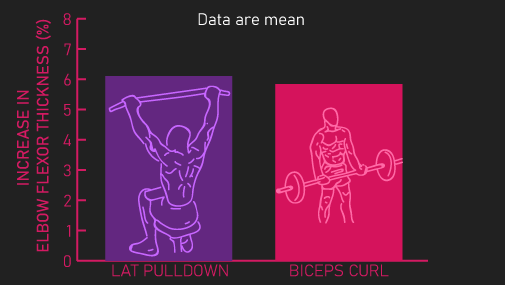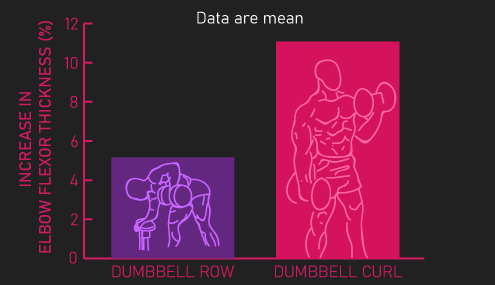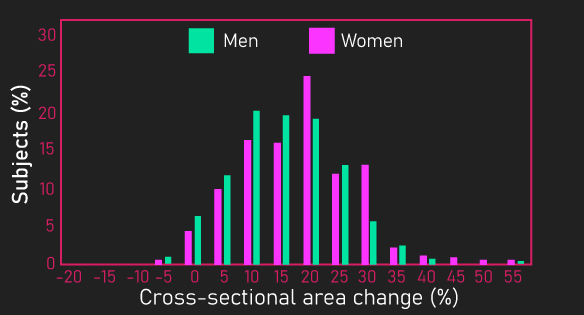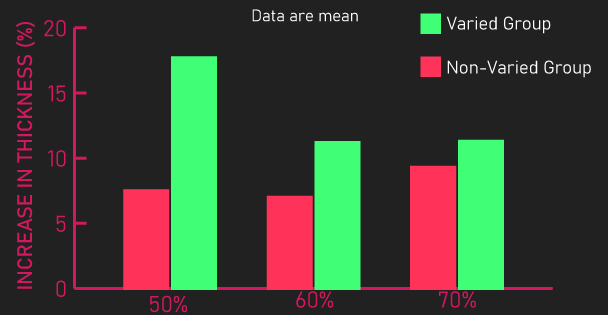
Rows and lat-pulldowns are two of the most popular back and biceps exercises performed in a program.
As far as back development goes, the inclusion of these two exercises in a program seems like a good idea, as they may be complementary.
The back consists of numerous muscles. Logically, as these two exercises require pulling motions at different angles, it would make sense that they should target different muscles of the back more so than others.
However, what about biceps development?
How do rows compare to lat-pulldowns for biceps growth?
Moreover, could the combination of rows and lat-pulldowns be enough for maximizing biceps hypertrophy?
Let us evaluate the evidence.
Lat Pulldowns for Biceps Growth
One potential way to assess the effectiveness of lat pulldowns (and rows) for biceps growth is to compare them to isolation biceps exercises, like biceps curls.
Isolation biceps exercises, like biceps curls, should logically be near ideal for biceps growth, as they confine tension to the biceps and ensure it is the limiting factor.
If lat pulldowns and rows can produce similar overall biceps hypertrophy to isolation biceps curls, we have some evidence to suggest that they could be sufficient for biceps development.
Exploring the lat pulldowns first, a study by Gentil et al. compared them to the barbell biceps curl.
Protocol: 29 untrained men were assigned to either train the lat pulldown or barbell biceps curl 2 times per week for a total of 10 weeks.
Each session, subjects trained their respective exercise for 3 sets of 8-12 repetitions to failure (the point at which no more repetitions can be performed).
Measurement: Thickness of the elbow flexors (including the biceps and brachialis muscles) was measured 10 centimeters from the cubital fossa.
Results: Increases in elbow flexor thickness were similar between the lat pulldown and biceps curl groups.

Therefore, this study suggests that lat pulldowns may be similarly effective to bicep curls for biceps development.
However, elbow flexor growth was only measured at one region (10 centimeters from the cubital fossa). As we’ll establish soon, this is likely an important limitation.
Rows for Biceps Growth
A study by Mannarino et al. compared dumbbell rows to dumbbell curls.
Protocol: 10 untrained men had one arm assigned to train dumbbell rows, while their other arm trained dumbbell curls.
They trained each arm with 4-6 sets of 8-12 repetitions to failure, twice per week for 8 weeks.
Measurements: Thickness of the elbow flexors (including the biceps and brachialis muscles) was measured at 25%, 50%, and 75% of the biceps length. The following results average out these three regions to obtain a single value.
Results: Increases in elbow flexor thickness were significantly greater for the arm trained with dumbbell curls.

Therefore, this study indicates rows are inferior for biceps growth compared to bicep curls.
I should mention that in this study, subjects performed both the curl and row with a supinated grip.
Dumbbell rows, or any rows for that matter, are typically performed with a neutral or pronated grip.
But, for the purposes of this study (exploring biceps growth), this would unlikely put rows at a disadvantage. In fact, supination would likely help biceps growth, given supination is one of the biceps functions.
Despite this, rows still were inferior to bicep curls.
Before moving on, if you’re curious about creating an effective training program for muscle hypertrophy, our high quality partner Alpha Progression can help. It can generate a highly effective program for you, track your workouts live with in-built progression recommendations, provide graphs displaying your long term progress, and it has a massive exercise database with more than 550 exercises.
Click HERE (the link opens in a new tab) to get a free 2 week trial of the apps features. If you like it and go beyond, the link also gives you 20% off a subscription!
We never promote trash at the House of Hypertrophy, so rest assured the app is high quality. The reviews speak to this, 4.8 starts (based on more than 7,000 reviews) on Google play, and 4.9 stars in Apple’s store (based on nearly 400 ratings).
Potential Problem
I want to mention a potential problem some individuals may have noticed.
Looking carefully back at the data of the studies, the Gentil et al. study found that lat pulldowns and barbell bicep curls resulted in a roughly 6% increase in elbow flexor thickness, while the Mannarino et al. study found that rows similarly increased elbow flexor thickness by 5.16%. Conversely, the dumbbell curls increased elbow flexor thickness by 11.06%.
Based on these numbers, you could argue that dumbbell bicep curls seem to be superior for biceps growth, while lat pulldowns, rows, and barbell curls (although producing similar biceps growth between them) are inferior.
However, this argument has its problems.
In all likelihood, dumbbell curls and barbell curls are probably similarly effective for biceps growth.
Different exercise modalities do not seem to have an impact on muscle growth. Machines seem to produce similar muscle growth to free weights. Also, bodyweight exercises can likely produce similar hypertrophy to free weights too.
These lines of evidence would go against the idea that there’s something special about dumbbell curls.
As an extra side note, these lines of evidence also explain why I think that despite the Mannarino et al. finding dumbbell rows to be inferior to curls, the results are probably also relevant to barbell rowing variations.
Anyway, logically, dumbbell and barbell curls involve more or less identical motions at the elbow. Moreover, in the studies, subjects performed 8-12 repetitions to failure. Combining these ideas, both the dumbbell and barbell curls would likely have induced similar tension on the biceps.
So, why did the dumbbell curl still produce the greatest percentage gains?
All in all, it’s most likely not sensible to combine and analyze the two studies by Gentil and Mannarino together.
Firstly, the Mannario et al. study used slightly higher volumes. Subjects performed 4-6 sets per session for their exercises compared to 3 sets in the Gentil et al. study.
More sets seem to cause more muscle growth (likely up to a certain point, probably when recovery abilities are diminished). Therefore, more sets in the Mannario et al. study could partly explain the higher percentage gains observed with the dumbbell curls.
Secondly, the two studies did not measure the biceps identically. The Gentil et al. study only took measurements at one region (10 centimeters from the cubital fossa), whereas the Mannario et al. took measurements (and then averaged) from 25%, 50%, and 75% of the muscles length.
Lastly, and probably most importantly, the studies were comprised of different subjects. Individual differences in responses to training are notable.
For instance, a study by Hubal et al. had 585 subjects (243 men and 342 women) train their biceps with preacher and concentration curls for 12 weeks.
The graph below depicts how varied the subject’s increase in biceps cross-sectional area was.

Most resistance training studies, like the Gentil and Mannario studies, have a fairly small sample size (10-30 subjects).
The probability of these two studies recruiting subjects with comparable ability to gain muscle is unlikely.
As a result, the simple fact these two studies used different subjects may further partly explain why the dumbbell curls produced greater growth in the Mannario et al. study.
Are Rows and Lat Pulldowns Enough?
So, when assessing the two studies, although it seems that rows are far less effective than biceps curls for biceps growth, lat pulldowns may be similarly effective to bicep curls.
From this, you may be tempted to think that rows and lat pulldowns could be sufficient for biceps development, given lat pulldowns may be itself enough for growing the biceps.
However, as alluded to earlier, the study by Gentil et al. finding lat pulldowns produced similar biceps growth to bicep curls is limited as it only measured elbow flexor growth at one region (10 centimeters from the cubital fossa).
Conversely, the study by Mannario et al. measured (and then subsequently averaged) three regions across the biceps (25%, 50%, and 75% of the muscle’s length), making it more insightful for overall biceps development.
The reason why it is useful to measure growth at many regions of a muscle is that muscles do not appear to grow uniformly.
Although Gentil et al. found similar growth between the lat pulldown and barbell biceps curl at one region of the muscle, it’s quite possible that at other regions growth responses would be different between the two exercises.
And this brings us on to probably the most important point of the article.
The research would appear to suggest that to maximize growth across regions of a muscle, a fair degree of exercise variation is important.
This would indicate that rows and lat pulldowns are not sufficient for biceps development.
A study by Costa et al. demonstrates this nicely.
They had a group of trained men (at least 6 months of experience) train 3 times per week for 9 weeks.
One group of subjects trained their biceps with lat pulldowns and barbell bicep curls each session.
Another group of subjects varied their exercises each week.
On day 1 of each week, their biceps were also trained with lat pulldowns (performed normally with the bar in front of them) and barbell bicep curls.
But on day 2 of each week, they trained with behind the neck lat pulldowns and preacher curls, and on day 3 of each week, lat pulldowns with a narrow grip and incline dumbbell curls.
As a note, both groups trained each exercise with 3 sets of 8-12 reps.
Before and after the study, the thickness of the elbow flexors was measured at 50%, 60%, and 70% of the upper arm length for both groups.
Overall, increases in thickness were greater for the group that varied their exercises, particularly at 50% and 60% of the upper arm length.

Therefore, front lat pulldowns and barbell biceps curl were inferior to a variety of lat pulldowns and curl variations.
It’s not clear whether it was the variation of lat pulldowns, variation of curls, or even the combination of both that produced the superior results for the varied group, but this study nonetheless demonstrates that a fair amount of exercise variety is beneficial for regional muscle growth, likely indirectly indicating rows and lat pulldowns are not sufficient for biceps development.
Remember to feel free to check out the Alpha Progression App if you’re interested. Also feel free to check out our free bench press e-book below.

